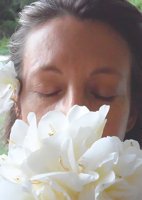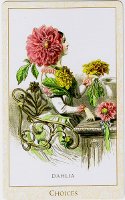
I first came across perfumer Dabney Rose on Twitter where her lyrical tweets about the plants in her greenhouse and gorgeous photographs of harvested flowers add a quiet loveliness to the ongoing chatter. Rose specializes in "flower waters," or hydrosols, the fragrant distilled water created by steaming or boiling fragrant plants and flowers — she uses a pressure cooker rather than an alembic — and "flower crèmes," buttery solids produced by enfleurage, the practice of laying blossoms on top of solid fat until it is impregnated with scent.
Like the blossoms they come from, flower waters and crèmes are fragile and ephemeral — most hydrosols will turn within six months — but their scents can be hauntingly true-to-life. When I rub Rose's hyacinth crème into my skin, what I smell is not perfume, or even the heady indoor scent of potted bulbs, but a growing hyacinth flower wafting from across a sunny yard. It's an uncanny experience, almost a visitation, and it feels right for the scent to fade after barely an hour.
I wanted to know more about the creator of this beauty, so I emailed Rose some questions. Below is an edited version of her generous answers. As a bonus, she provided basic instructions for trying out enfleurage at home (see the end of the interview).
Your father was a chemist — you told me that he taught you how to distill fragrance. Did growing up with him affect your current work?
I grew up in a heavily chemical-laden environment — the Kanawha Valley was a rash of city-sized chemical plants and the sky was often a weird color. It was just the air you had to breathe. At the same time my young ‘nose’ was developing itself as it could with the natural world and its smells: life on horseback and the accompanying fragrance world, walking for hours exploring creek banks looking for fossils, smelling the way the plant growth enveloped my private afternoons. Somehow I have emerged as a purist and a simpleton — I don’t even like taking aspirin.
Were you always a woman with a greenhouse?
I always pretended I had a greenhouse! Everywhere that I have lived I’ve had plants harbored in all the bright spots around the house. My husband would complain that the plants all had the best seats, and he was absolutely right. I once moved into a place that had no running water but the whole south wall was double paned windows and the dominant thought firing through my brain was, “Think of the plants I could grow in here!"
I’ve also had numerous nursery jobs, working in greenhouses, so I knew what having one felt like. Manifesting one in my own personal reality was just a matter of time.
Which came first, plants or fragrance?
I will say fragrance. I know my mom had flowers in beds but I only remember the fragrant ones: peonies, Sweet William, wild plum on the back lot.
[Plant] fragrance is a real lightning rod for me. I am a slave to it. It’s ethereal, ephemeral, a bridge from the spiritual to the physical realm and I see it as my own personal path in life to try and ground it and share it's beauty with others. It’s a gift from heaven funneled through a flower’s throat that no contrived, concocted perfume can match. Hydrosols and enfleurage come to closest to capturing its authenticity.
Please describe a typical day for us — how much time do you spend in the greenhouse or your garden? How much in your lab? Do you even call it a lab?
Hee, hee! My greenhouse is the lab, as that is where I "grow fragrance." Actually, the whole garden is geared towards that, but the garden is seasonal.
On a typical summer day when everything is in full swing, first thing out of bed in the morning I go out to harvest the flowers that bloomed in the night, like Evening Primrose, so I can get them before the sun does. The primrose in particular I bring inside, grind in a mortar & pestle into a salt paste and add it to a jar of primrose paste that I keep in the fridge. This will be distilled later when I have a good quantity. Sometimes, the harvest is a flower or two, sometimes 30 to 40.
On really busy days I’ll start distilling one batch in the morning and another in the afternoon. For distillation and for enfleurage I harvest the flowers when their voices have loosened up — that varies depending on the time of year and type of flower. As a plant does not open up its flowers all at once, sometimes I will go out to the rose bushes two or three times a day. I get run ragged on some days but then I remember it’s a choice, and I keep a’going.

In your tweets, you write about your fragrant plants as though they were pets or friends. You refer to them as "he" or "she." They sing in the corner of the greenhouse. You feel regret about harvesting their blossoms. Would you say plants have personalities?
Plants are "people"! They seem to be more on my radar than humans are. When I walk or drive in a new place I "plant watch." ( People don’t interest me as much.) I feel the energy fields of plants overlap with mine when I am working with them, kind of like "rubbing shoulders." I can walk past a plant and feel it reach out to me like a cat pawing in play. I can feel when one is thirsty...[and] yes, they very much "sing" to me via their scents. As far as personalities, for me it comes from their voices — I know a chemist would say it is the chemistry of their fragrance molecules.

How to try Enfleurage at Home
These are deceptively simple instructions for what is essentially an art form learned through trial and error, but they are enough to get you started.
"The equipment for enfleurage is probably already in your kitchen," says Rose. She uses wide, shallow Pyrex pans — glass is preferable because it is non-reactive — and solid coconut oil as her fat. I found some virgin coconut oil at my local health food store, but in a pinch you can use another solid, neutral fat such as vegetable shortening. Avoid fats with a strong scent or flavor.
Melt enough fat to cover the bottom of the pan with a thin layer, about 1/8 of an inch. When it cools and becomes solid again, begin placing the flowers of your choice (intensely fragrant blossoms like hyacinth and jasmine are ideal) face down in the fat. Use a light touch — you want them to just rest on the surface. "So they can still breathe," says Rose.
Let the pan sit uncovered until the flowers lose their scent — anywhere from 24 hours to three days. Just pick them up and sniff to see if they are still fragrant.
Repeat the process until the fat is highly fragrant. Some flowers require very little repetition, others more. You can test the fat by dipping your finger in it and smearing some on your skin.
To make her "crèmes," Rose mixes the fragrant fat with melted beeswax to stabilize it, but you can simply spread it on your skin. If the flowers you've used are edible you can also try using the fragrant fat as an ingredient — I imagine it would be a wonderful way to flavor butter or frostings for sweet dishes.
Note: all images supplied by Dabney Rose.
This is very informative. I am with you on “it would be a wonderful way to flavor butter or frostings for sweet dishes.”–any idea on what some of the more fragrant edible flowers are?
Well, jasmine, violets and roses all come immediately to mind. I’ve made crystallized jasmine blossoms before–it’s time consuming but so pretty and actually quite delicious! Osmanthus blossoms (sweet olive here in the U.S.) are used in food throughout Asia. And I’d guess all the fruit tree blossoms would be fair game, citrus too, though I’d want to check. People do make lilac wine, though I’ve seen some discussion about ingesting large quantities of lilacs. The rest I’d want to look up first!
Making crystallised petals is time consuming but worthwhile. Preserving fruits and flowers in sugar is a very Provençal tradition. You can sometimes find them in gourmet food and confectionery stores.
Probably a more sensible way to attain them! But I’ve never seen crystallized jasmine so I had to try it.
Thanks for this very interesting interview Alyssa!
Very glad you enjoyed it!
What an intriguing interview about an unusual passion. I enjoyed reading this today.
I love the mix of spirit, art and science evident in her answers.
This was really interesting, Alyssa, thank you for posting it. Dabney Rose’s outlook is wonderfully refreshing! I had no idea creating such gorgeous scented goodies was so relatively simple. I use coconut oil all the time on my skin and I think a beautiful osmanthus scent would be lovely.
I wish you luck! Talking to Dabney, I got the idea that it might not be as easy as she makes it look. But definitely worth a try or five.
I too doubt it will be easy but it is definitely worth a try or five! I’ll report back on how it goes…
Report back!.
Alyssa, I really enjoyed this article, thank you! Dabney Rose sounds like a joyous soul and kindred spirit.
Indeed!
Alyssa has done a Fabulous review here & i am most flattered!!
I have actually cooked scallops in these ‘butters’; lemon blossom & ginger lily & it made me want to swoon!
Osmanthus would make another delight!
I hope to do more of these as the wheel of the year turns.
Oh my, that sounds amazing! Must get that Meyer Lemon tree producing enough blooms to sacrifice some. *ponders buying a second tree to reserve for blooms* *maybe two*
Do you think I could just spritz my Ginger Flower water directly onto the scallops? Guess it couldn’t hurt to try…
Alyssa, I have indeed cooked them in hydrosol as well ; )…I’ve been working on a blog entry about this…time to get going on it!
Yes, please!
Fascinating, Alyssa – I think I’m going to get hooked on Dabney!
I wish I could steal flowers from the amazing viburnum I encountered last spring in my neighborhood – it has the most wonderful scent: like vintage Bellodgia with indoles instead of sandalwood. And there are all sorts of magnolias, too. None of them mine, though, so I’ll seek these treasures through the internet.
It sounds like you need to get to know your neigbors! I bet if you were willing to share the results of your experiments they might be willing to donate some flowers to the cause.